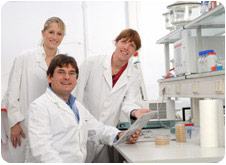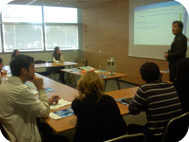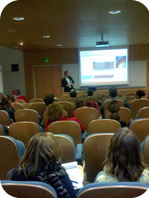LabCluster spécial BIOLOGIE SPATIALEParc
scientifique et technologique de Luminy
|
|
La participation est gratuite sur inscription Il est possible de participer à la totalité de l'événement ou seulement à une ou plusieurs conférences. |
|||||
| Cliquez ici pour vous inscrire |
|
||||
Programme :
| |
8h30 | Coffee and Pastries Welcome participants 9h00-9h30 | AKOYA BIOSCIENCES | Scaling up deep Spatial Phenotyping with a novel Omics approach for Biomarker Discovery Scaling up deep Spatial Phenotyping with a novel Omics approach for Biomarker Discovery Akoya Biosciences offers Scalable Spatial Phenotyping Solutions from Discovery to Clinical Research. From the Discovery side with the PhenoCycler-Fusion that combines the strengths of Akoya’s automated, ultrahigh-plex cycling platform, PhenoCycler™, and the high-speed imaging platform, PhenoImager™, into an integrated end-to-end workflow. PhenoCycler-Fusion 2.0 is a high-throughput spatial biology platform capable of running 40 samples in a given week. To make this possible PhenoCyclerFusion 2.0 utilizes rapid fluidics and multi-slide automation to meet the scale of your discovery research. To the clinical Research with PhenoImager® HT 2.0, the fastest solution for the development of spatial signatures, powered by Akoya’s patented Multispectral Imaging (MSI) and spectral unmixing technologies that enables rapid and accurate spatial phenotyping at scale. Join us to hear about the most trusted Spatial Biology Platforms cited in 1,000+ publications. 9h30-10h00 | LEVITAS BIO | Overcoming Sample Quality Challenges for Single Cell Analysis Levitation Technology is a novel approach to sample preparation, helping researchers overcome sample quality limitations. With a process that is user-friendly, fast, and compatible with all cell types, Levitation ensures high-quality single-cell genomic data, even from challenging or delicate specimens. 10h00-10h30 |LEICA MICROSYSTEMS | The power of Spatial Biology: Identify targets, collect and analyze Within a tissue, individual cells of the same type may behave differently based on variations in their microenvironment. Transcriptomics and proteomics methods such as mass spectrometry sequencing typically only provide small snapshots of information that are often challenging to piece together. In contrast, microscopy enables researchers to look at the bigger picture and track proteins and other biomarkers at a single cell level to better understand the whole tissue landscape. Multicolor imaging (also known as multiplexing) enables researchers to use multiple fluorophores within the same sample, allowing related components and processes to be observed in parallel. This adds more context to your observations and consequently provides more meaningful results. Since multiplexing requires the use of multiple fluorophores to stain the various markers of interest, choosing the right fluorophore combination for your experiment is critical and minimizing crosstalk is key. However, traditional methods to reduce crosstalk are slow and can involve tedious manual adjustments or a high degree of technical microscopy knowledge. Normal and diseased tissues can be mapped to reveal the spatial relationships of 60+ biomarkers in a single tissue section. This antibody-based “hyperplexed” workflow to examine spatial cell biology and function is enabled using the Cell DIVE Multiplexed Imaging Solution. Sometimes, specific areas of a sample need to be isolated for downstream analysis or to decipher the details within a specific region, free of contamination. For example, in cancer biology there are distinct molecular differences between tumor and non-tumor regions, as well as in the tumor itself. These can only be deciphered by isolating specific, minute sections of these regions. Laser MicroDissection (LMD), or Laser Capture Microdissection (LCM), is a method designed to isolate and dissect target cells or entire areas of tissue from a wide variety of samples. | Coffee Break 11h00 -11h30 | NANOSTRING | Multi-Omic Spatial Profiling to Unravel Complex Biology Join us in Marseille to learn how to gain a more complete picture of biology with Spatial Multiomics. You can now simultaneously spatially profile thousands of transcripts and hundreds of proteins from the same formalin-fixed, paraffin-embedded (FFPE) tissue section using true, same-slide spatial multiomics with the GeoMx® Digital Spatial Profiler (DSP). The 570+ plex GeoMx® IO Proteome Atlas can be combined with either the GeoMx® Human Whole Transcriptome Atlas or GeoMx® Cancer Transcriptome Atlas to maximize your discovery power and get you a more complete picture of biology. Thanks to its multi-modal approach for true single-cell segmentation, the CosMx™ Spatial Molecular Imager (SMI) allows you to view 64 proteins with subcellular resolution. Participate in this Labcluster event and discover how the GeoMx DSP and CosMx SMI are revolutionizing research in fields such as cancer, immunology, and neuroscience. To know more, visit : www.nanostring.com 11h30-12h00 | LUNAPHORE| Profiling the tumor microenvironment with fully automated spatial biology Novel technologies that deliver single-cell data have shed new light on biological processes and brought many exciting findings into life science research. Easy access to omics technologies is needed to push the boundaries of research and fill the high demand for it. Lunaphore aims to fill that gap and bring spatial context to single-cell assays. Here, we will show how to generate reproducible spatial data with COMET™, a universal hyperplex solution for high-throughput spatial multimers. The COMET™ platform performs sequential immunofluorescence (seqIF™) assays to detect 40 protein targets per automated run. Guided workflow optimization and flexibility of the system to use the off-shelf reagents allow fast and easy adoption of the methodology in every laboratory, enabling researchers to explore the cellular microenvironment from assay development to cohort analysis in a few weeks. Here, we will also present our new fully automated, spatial multiomics workflow that integrates the simultaneous detection of RNA, with RNAscope™ HiPlex, and protein, with seqIF™, on the same tissue section at the single-cell level. Stands en libre accès toute la matinée, AVEC LA PARTICIPATION DE MGI TECH ••••••••••••••••••••••••••••••••••••••••••••••••••••••• ••••••••••••••••••••••••••••••••••••••••••••••••••••••• |
||
|
Stands de démonstration et d'information en libre accès. Venez nous rencontrer. |
|||

| Le nombre de places étant limité, il est fortement conseillé de s'inscrire à l'avance en cliquant ici |
|
|||
| Pour toute question ou demande d'information, cliquez ici | |
![]()



